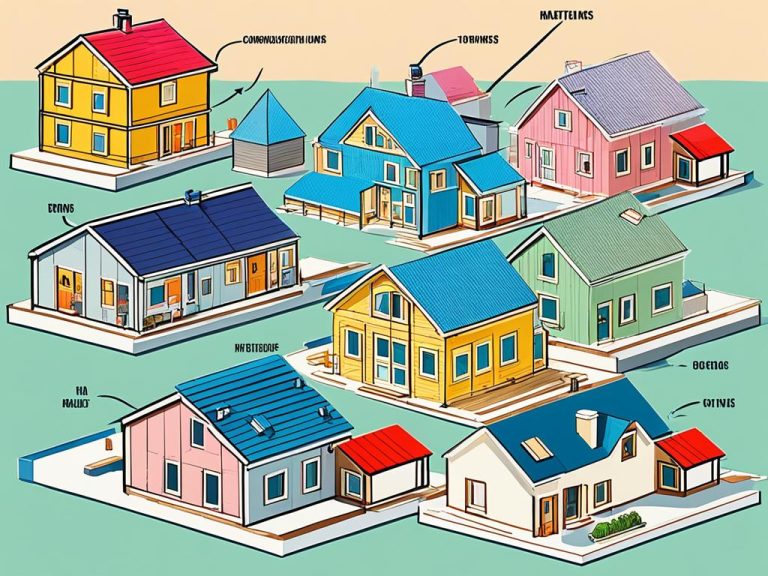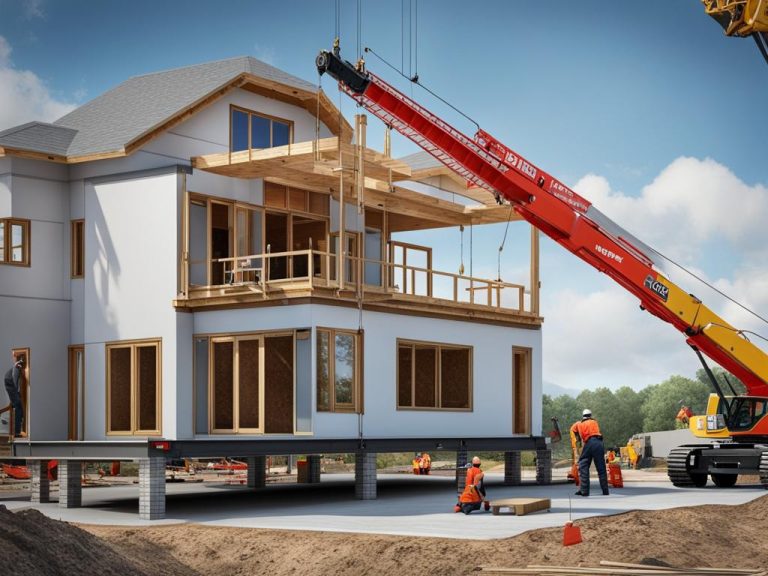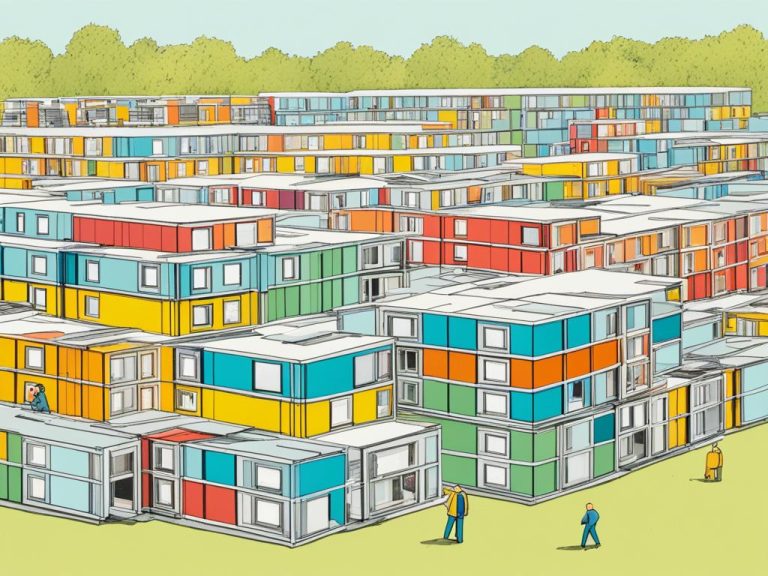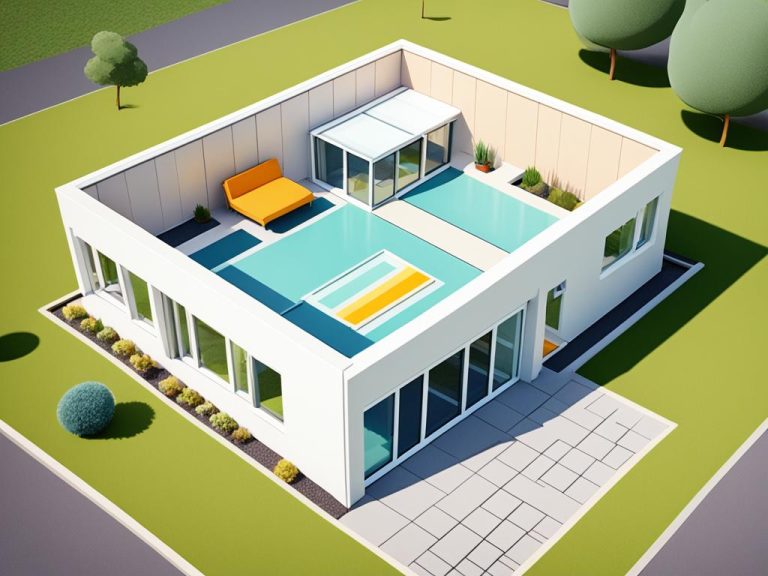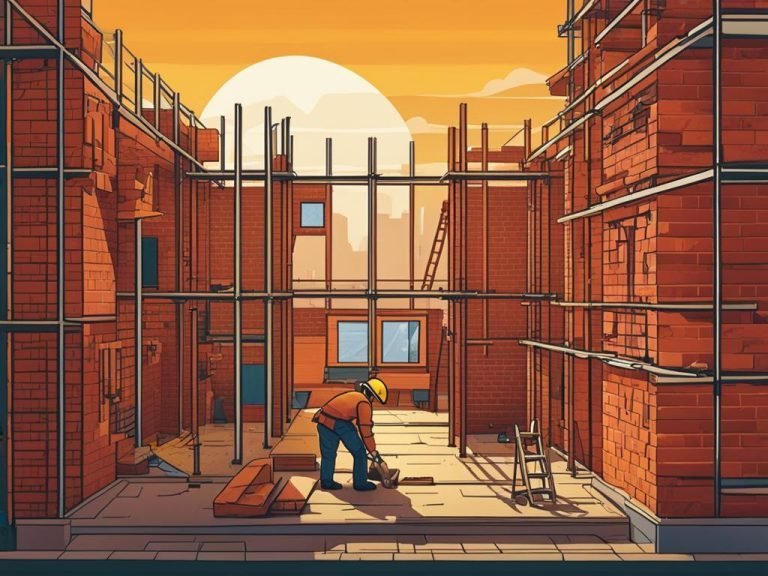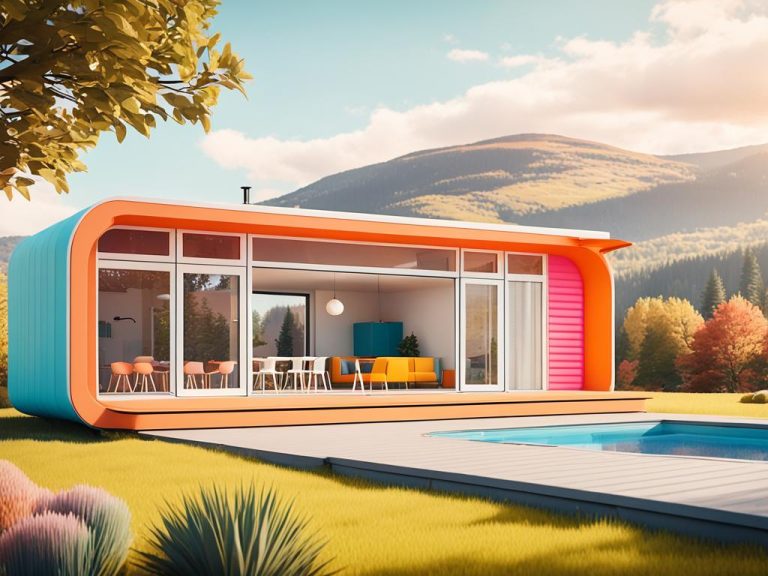Building a Modular Home: Covering the Essentials
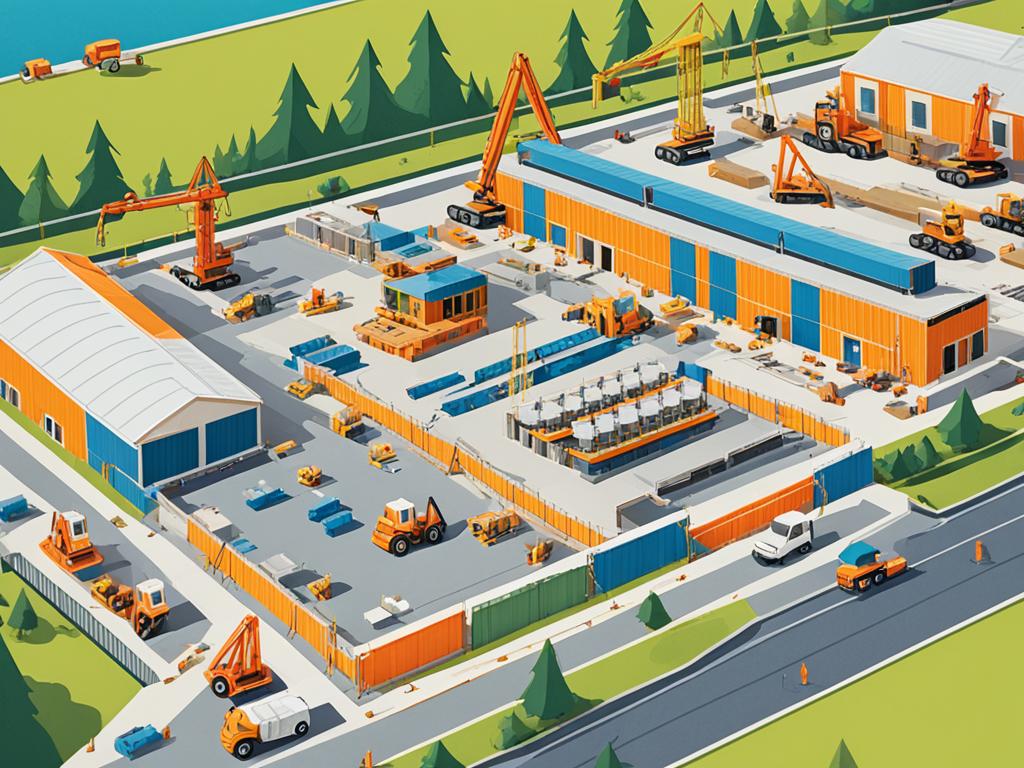
Building a modular home is a growing trend in the UK housing market. Modular homes are houses that are built in a factory and then transported to the specified building location. They offer numerous benefits, including lower costs, energy efficiency, customizability, quicker installation, and good investment potential. However, there are also factors to consider such as additional costs for electrical and plumbing services, travel costs, upfront builder payments, land ownership, and planning permission requirements.
Materials used for modular homes include a variety of options for both the interior and exterior, with lightweight tiles being a popular choice for roofing. The construction and transportation of modular homes require careful considerations, and regular maintenance is necessary to keep the home in optimal condition. It is also important to be aware of the different types of foundations available for modular homes, such as raft foundations, strip foundations, pad foundations, deep foundations, and basement foundations. The cost of foundations can vary depending on the soil and topography of the site.
Overall, building a modular home offers a unique and efficient way to create a dream property.
Key Takeaways
- Modular homes are houses built in a factory and transported to the building location.
- They offer benefits such as lower costs, energy efficiency, customizability, and quicker installation.
- Consider additional costs for electrical and plumbing services, travel costs, upfront builder payments, land ownership, and planning permission requirements.
- Modular homes use a variety of materials for both the interior and exterior, including lightweight tiles for roofs.
- Different types of foundations, such as raft foundations and basement foundations, can be used for modular homes.
What is a Modular Home?
A modular home is a house that is built within a factory and then transported to the specified building location. It is not designed to be disassembled or moved to a new location like mobile homes. Modular homes have evolved from being simple and cheap solutions to now offering high-quality living spaces. They are increasingly popular in the UK housing market and are seen as a viable alternative to traditional on-site construction.
Modular homes, also known as prefabricated buildings, are built in sections or modules in a factory setting. These sections are then transported to the building site, where they are assembled and joined together to create the complete home. This construction method allows for faster and more efficient building compared to traditional on-site construction. It also reduces construction waste and disruption to the surrounding environment.
Modular homes offer a range of benefits for homeowners. They provide a more affordable housing option, as the controlled factory environment and streamlined construction process result in lower costs compared to traditional homes. Additionally, modular homes are known for their energy efficiency. The building process allows for better insulation and sealing, resulting in lower energy consumption and reduced utility bills.
The housing market in the UK is increasingly embracing modular homes as a solution to the housing shortage. With their customizable designs, quick construction time, and cost-effective nature, modular homes are attracting the attention of both individuals and property developers.
Whether you are looking for a first home or considering downsizing, modular homes offer a modern and sustainable housing option that meets the needs of today’s homeowners.

The Rise of Modular Homes in the UK Housing Market
Over the past decade, modular homes have gained popularity in the UK housing market due to their numerous advantages. These prefabricated buildings are revolutionizing the way homes are constructed, offering a faster, more cost-effective alternative to traditional on-site construction.
- Quick Installation: Modular homes are built in a factory, which significantly reduces construction time. The controlled environment allows for efficient production, resulting in faster installation once the modules are transported to the building site.
- Customizability: One of the key advantages of modular homes is their customizability. Homeowners have the flexibility to choose from a variety of floor plans, finishes, and other design elements to create a home that suits their specific needs and preferences.
- Energy Efficiency: Modular homes are designed with energy efficiency in mind. The factory-controlled construction process enables the use of high-quality insulation materials and efficient heating and cooling systems, reducing energy consumption and lowering utility bills.
- Lower Costs: Compared to traditional on-site construction, modular homes are generally more cost-effective. The streamlined manufacturing process, reduced material waste, and shorter construction time all contribute to lower overall costs for homeowners.
- Durability and Quality: Factory-built modular homes undergo stringent quality control measures to ensure they meet the highest standards. The construction process allows for precision and accuracy, resulting in sturdy, well-built homes that are built to last.
As the housing market continues to evolve, modular homes are becoming an increasingly attractive option for those seeking affordable, energy-efficient, and customizable housing solutions. With their many benefits, it’s no wonder that modular homes are changing the landscape of the UK housing market.
Benefits of Modular Homes
Modular homes offer numerous benefits compared to traditional on-site construction. With their energy-efficient design and insulation, modular homes help homeowners save on heating bills and reduce their environmental impact. Additionally, modular homes can be easily customized to incorporate solar panels, further enhancing their energy efficiency and sustainability.
One of the most significant advantages of modular homes is lower costs. Due to the streamlined manufacturing process, modular homes require less labor and materials, resulting in overall cost savings. Homeowners can enjoy a high-quality, energy-efficient home at a fraction of the cost of traditional construction. This affordability makes modular homes an attractive option for those looking to enter the UK housing market or invest in rental properties.
Another key benefit of modular homes is their quick delivery and installation. The manufacturing process occurs indoors, unaffected by weather delays, ensuring speedy completion. In just a few weeks, a standard modular home can be built and ready to move in. This rapid construction timeframe is especially advantageous for those in need of immediate housing solutions or seeking to generate rental income quickly.
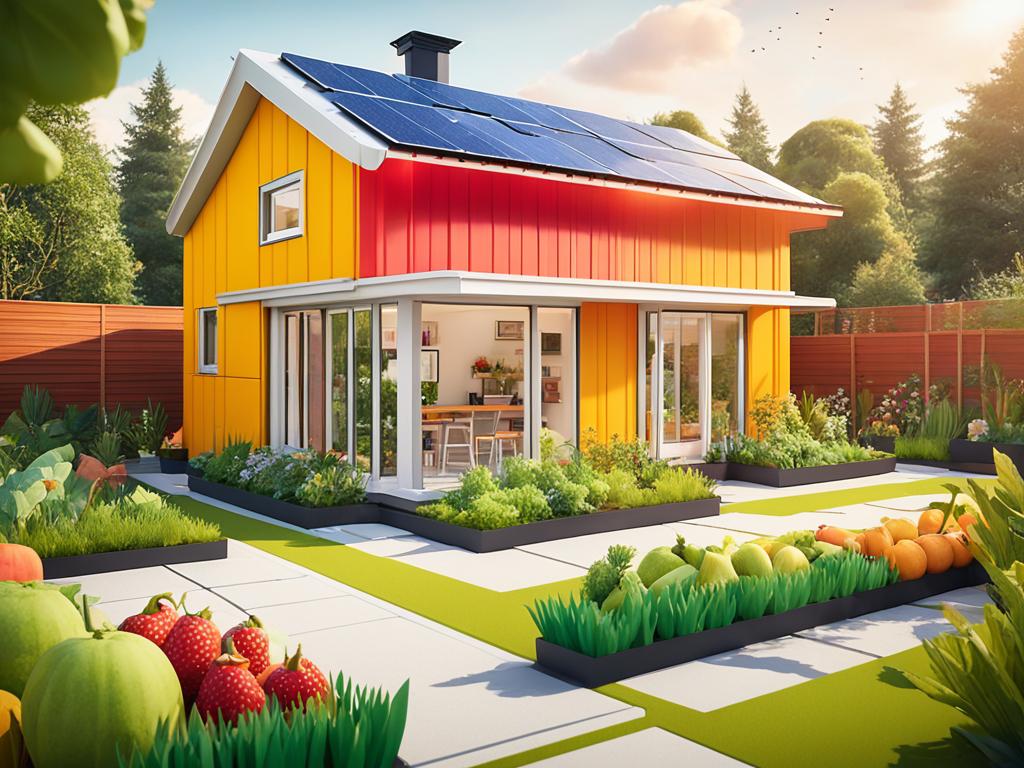
Modular homes also offer excellent investment potential. As the demand for energy-efficient and affordable housing continues to rise, modular homes present a lucrative opportunity for investors. The value of modular homes is likely to increase over time, making them a smart long-term investment choice. Whether used as primary residences or rental properties, modular homes offer the potential for both financial stability and growth.
Materials Used for Modular Homes
Modular homes utilize a variety of materials for both the interior and exterior, offering endless possibilities for customization and durability. The materials used in the interior of modular homes are often similar to those found in traditional houses, creating a comfortable and inviting living space.
For the exterior, modular homes can be constructed using a range of materials that suit the desired aesthetic and structural requirements. Stone, brick, wood, and other materials are commonly used to create the exterior walls and facades of modular homes. These materials provide strength, durability, and can be customized to fit various architectural styles.
When it comes to the roof of a modular home, lightweight tiles are a popular choice. Lightweight steel tiles, in particular, offer a combination of strength, longevity, and cost-effectiveness. These tiles not only provide protection against the elements but also contribute to the overall aesthetics of the home.

Cladding and finishing touches are often added on-site to enhance the exterior look of the modular home, further personalizing it to the homeowner’s taste.
The use of high-quality materials ensures that modular homes are built to last, offering a sustainable and resilient housing option for individuals and families alike.
Building and Transportation of Modular Homes
Once the modular home design is finalized and approved, the construction process begins in a controlled factory environment. This controlled setting allows for faster and more efficient construction compared to traditional on-site building methods. The panels that form the walls, floor, and roof of the modular home are precisely manufactured and assembled with precision.
When it comes to transportation, careful planning and considerations are made to ensure the safe delivery of the modular home to its building location. Factors such as travel distances, the method of transportation, load dimensions, and machinery during loading and arrival are taken into account.
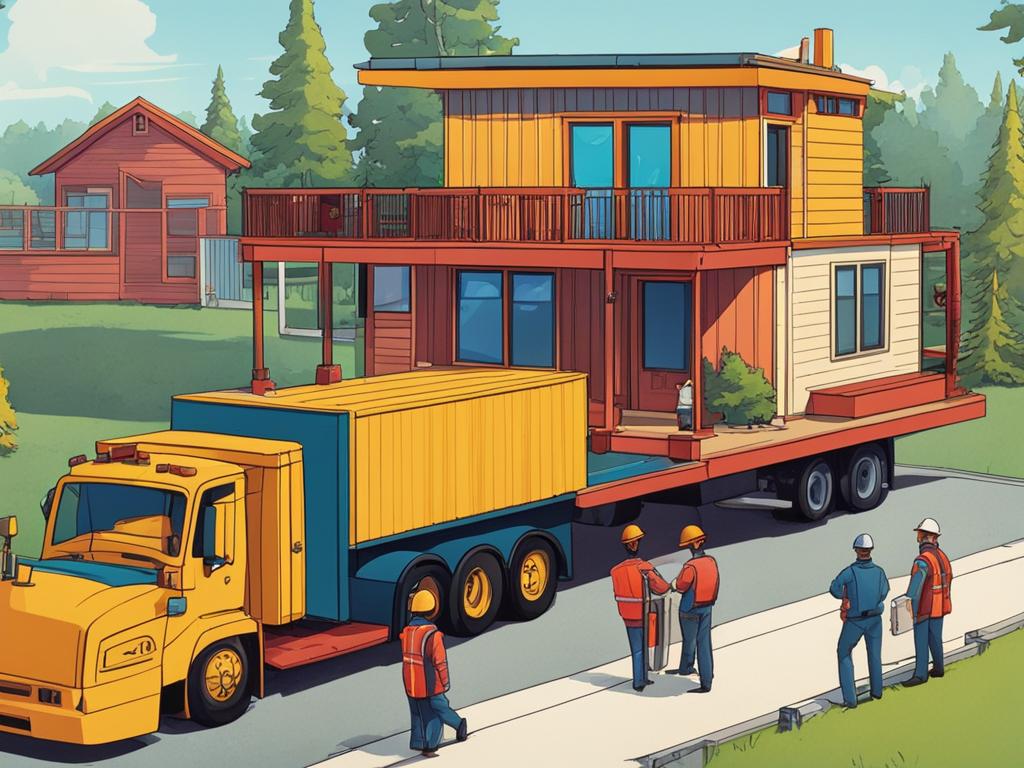
The transportation process aims to ensure that the modular home reaches its destination without any damage or issues. The panels are securely loaded and transported to the building site, where they will be lifted and placed into their designated positions.
The use of cranes is common during the installation process, as they allow for precise positioning of the modular home modules. Once in place, the modules are secured together to form a complete and structurally sound home.
Overall, the construction and transportation of modular homes require meticulous planning and execution. From the factory to the building site, every step is carefully coordinated to ensure a smooth and successful process.
Maintenance of Modular Homes
Regular maintenance is essential for ensuring that modular homes remain in optimal condition. By performing regular maintenance tasks, homeowners can prolong the lifespan of their modular homes and prevent costly repairs. Here are some important maintenance tasks to consider:
Seasonal Maintenance
- In winter, remove ice buildup from the roof to prevent damage and leaks.
- During spring, inspect the roof for any missing tiles and replace them promptly.
- In summer, check and clean the air conditioner filters to ensure optimal performance.
- During autumn, remove debris from the roof to prevent clogging and potential water damage.
By addressing these seasonal maintenance tasks, homeowners can protect their modular homes from the elements and ensure that they remain in good condition throughout the year.
Insulation
Proper insulation is crucial for maintaining energy efficiency in modular homes. Regularly check the insulation to ensure it is intact and providing effective heat retention. If any areas of insulation are damaged or deteriorating, make the necessary repairs or replacements to optimize energy efficiency and comfort.
Roof Maintenance
The roof is a vital component of any home, including modular homes. Regularly inspect the roof for signs of damage, such as missing tiles, cracks, or leaks. Address any issues promptly to prevent further damage to the interior of the home. Additionally, consider scheduling professional roof inspections every few years to ensure the roof remains in good condition and to identify any potential issues early on.
By performing these maintenance tasks on a regular basis, modular homeowners can protect their investment, maintain energy efficiency, and ensure a comfortable living environment. Remember, preventive maintenance is key to avoiding larger, more costly repairs down the line.
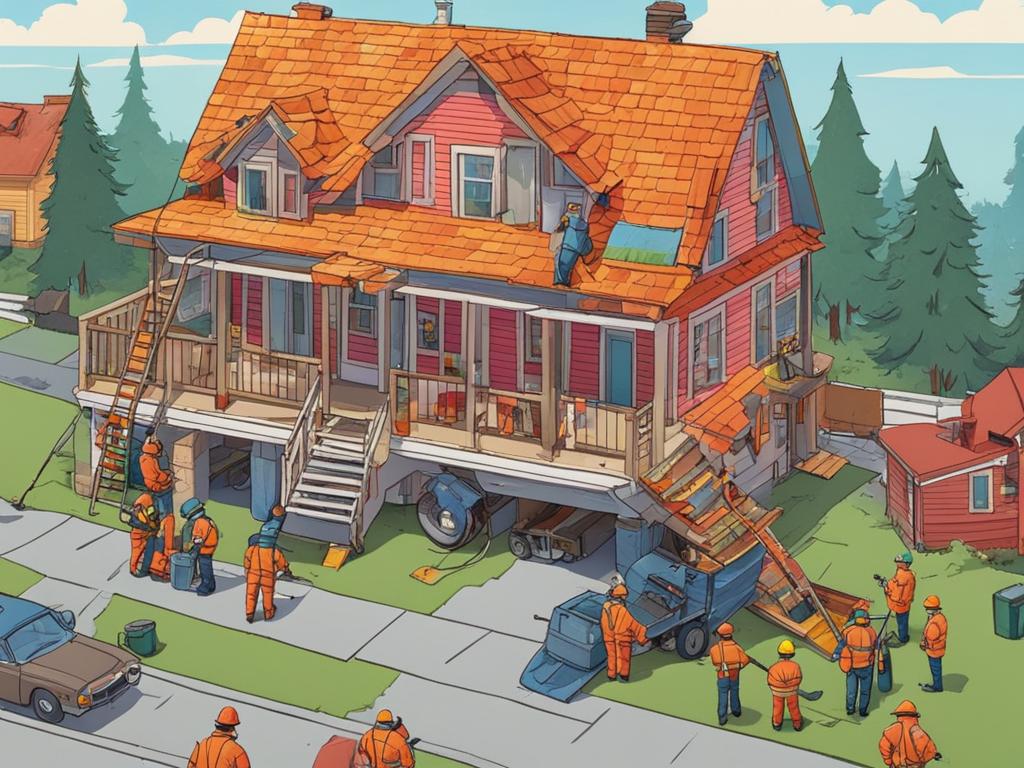
Types of Foundations for Modular Homes
The foundations for modular homes can vary depending on the specific site conditions. When it comes to supporting modular homes, there are several options to consider.
Raft foundations, which involve pouring a slab directly on the ground, are often suitable for modular homes due to their load-bearing walls. This type of foundation provides a solid base for the home and helps distribute the weight evenly.
Strip foundations, which involve trenches filled with concrete, can also be used. These foundations are commonly used in areas with stable soil conditions and provide excellent support for modular homes.
For specific load-bearing points or sloped sites, pad foundations may be necessary. These foundations consist of individual concrete pads that support each load-bearing point of the home, ensuring stability and strength.
In cases where the ground conditions do not provide adequate support, deep foundations, such as steel or concrete piles, may be required. These foundations extend deep into the ground to ensure the stability of the modular home.
For those seeking additional storage or living space, basement foundations are an option. Basement foundations provide extra square footage and can be customized to fit the specific needs of the homeowner.
The cost of foundations can vary depending on the ground conditions and the specific type of foundation chosen. It is important to consult with a modular home manufacturer and an engineer to determine the most suitable foundation for the site.
FAQ
What is a modular home?
A modular home is a house that is built within a factory and then transported to the specified building location. It is not designed to be disassembled or moved to a new location like mobile homes. Modular homes have evolved from being simple and cheap solutions to now offering high-quality living spaces. They are increasingly popular in the UK housing market and are seen as a viable alternative to traditional on-site construction.
What are the benefits of modular homes?
Modular homes offer numerous benefits compared to traditional on-site construction. They are more energy-efficient, thanks to their tight specifications and insulation. This can result in lower heating bills or the use of solar panels for energy conservation. Modular homes also offer cost advantages, with reduced labor and material costs leading to overall lower costs compared to traditional homes. They are quicker to install because the manufacturing process occurs indoors, and a standard property can be built in just a few weeks. Additionally, modular homes have good investment potential, as their value is likely to increase over time.
What materials are used for modular homes?
Modular homes use a variety of materials for both the interior and exterior. The interior materials are often the same as those used in traditional houses. For the exterior, modular homes can be made of stone, brick, wood, or other materials. Cladding and finishing touches are often installed on-site to ensure a great look. Lightweight tiles, such as steel tiles, are a popular roofing choice for their strength, durability, and cost-effectiveness.
How are modular homes constructed and transported?
The construction of modular homes takes place in a factory before they are transported to the building location. The manufacturing process in a controlled environment ensures faster and more efficient construction. The transportation process requires careful planning and considerations, including travel distances, method of transportation, load dimensions, and machinery during loading and arrival at the location. The panels that form the walls, floor, and roof of the modular home are easily transported without damage. Upon reaching the destination, the modules are lifted by a crane and placed into their designated positions for final installation.
How do I maintain a modular home?
Regular maintenance is important for modular homes to ensure they remain in optimal condition. Seasonal maintenance tasks include removing ice buildup from the roof during winter, checking insulation for effective heat retention, and inspecting the roof for missing tiles in spring. During summer, it is important to check the air conditioner filters and ensure they are clean. In autumn, debris should be removed from the roof to prevent buildup. Following these maintenance tasks will help prolong the lifespan of the modular home.
What types of foundations are suitable for modular homes?
The foundations for modular homes can vary depending on the specific site conditions. Raft foundations, which involve pouring a slab directly on the ground, are often suitable for modular homes due to their load-bearing walls. Strip foundations, which involve trenches filled with concrete, can also be used. Pad foundations may be necessary for specific load-bearing points or sloped sites. Deep foundations, such as steel or concrete piles, may be required for ground conditions that do not provide adequate support. Basement foundations are an option for those seeking additional storage or living space. The cost of foundations can vary depending on the ground conditions and the specific type of foundation chosen. It is important to consult with a modular home manufacturer and an engineer to determine the most suitable foundation for the site.

